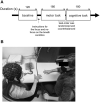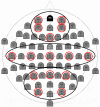EEG brain oscillations are modulated by interoception in response to a synchronized motor vs. cognitive task
- PMID: 36213612
- PMCID: PMC9540215
- DOI: 10.3389/fnana.2022.991522
EEG brain oscillations are modulated by interoception in response to a synchronized motor vs. cognitive task
Abstract
So far, little is known about how conscious attention to internal body signals, that is, interoception, affects the synchronization with another person, a necessary or required social process that promotes affiliations and cooperation during daily joint social interactions. The effect of explicit interoceptive attentiveness (IA) modulation, conceived as the focus on the breath for a given time interval, on electrophysiological (EEG) correlates during an interpersonal motor task compared with a cognitive synchronization task was investigated in this study. A total of 28 healthy participants performed a motor and a cognitive synchronization task during the focus and no-focus breath conditions. During the tasks, frequency bands (delta, theta, alpha, and beta bands) from the frontal, temporo-central, and parieto-occipital regions of interest (ROIs) were acquired. According to the results, significantly higher delta and theta power were found in the focus condition in the frontal ROI during the execution of the motor than the cognitive synchronization task. Moreover, in the same experimental condition, delta and beta band power increased in the temporo-central ROI. The current study suggested two main patterns of frequency band modulation during the execution of a motor compared with the cognitive synchronization task while a person is focusing the attention on one's breath. This study can be considered as the first attempt to classify the different effects of interoceptive manipulation on motor and cognitive synchronization tasks using neurophysiological measures.
Keywords: EEG; cognitive task; interoceptive attentiveness; motor task; synchronization task.
Copyright © 2022 Angioletti and Balconi.
Conflict of interest statement
The authors declare that the research was conducted in the absence of any commercial or financial relationships that could be construed as a potential conflict of interest.
Figures




Similar articles
-
Electrophysiology of interoception: Parietal posterior area supports social synchronization.Soc Neurosci. 2023 Feb;18(1):16-27. doi: 10.1080/17470919.2023.2202876. Epub 2023 Apr 18. Soc Neurosci. 2023. PMID: 37046399
-
Delta-Alpha EEG pattern reflects the interoceptive focus effect on interpersonal motor synchronization.Front Neuroergon. 2022 Oct 25;3:1012810. doi: 10.3389/fnrgo.2022.1012810. eCollection 2022. Front Neuroergon. 2022. PMID: 38235477 Free PMC article.
-
Dyadic inter-brain EEG coherence induced by interoceptive hyperscanning.Sci Rep. 2023 Mar 16;13(1):4344. doi: 10.1038/s41598-023-31494-y. Sci Rep. 2023. PMID: 36927763 Free PMC article.
-
[Psychophysiologic and clinical aspects of EEG synchronization related to cognitive processes].Ideggyogy Sz. 2005 Nov 20;58(11-12):393-401. Ideggyogy Sz. 2005. PMID: 16491564 Review. Hungarian.
-
The functional significance of delta oscillations in cognitive processing.Front Integr Neurosci. 2013 Dec 5;7:83. doi: 10.3389/fnint.2013.00083. Front Integr Neurosci. 2013. PMID: 24367301 Free PMC article. Review.
Cited by
-
Social Interoception and Autonomic System Reactivity during Synchronization Behavior.Behav Sci (Basel). 2024 Feb 20;14(3):149. doi: 10.3390/bs14030149. Behav Sci (Basel). 2024. PMID: 38540452 Free PMC article.
-
Does emotional valence affect cognitive performance and neurophysiological response during decision making? A preliminary study.Front Neurosci. 2024 Aug 9;18:1408526. doi: 10.3389/fnins.2024.1408526. eCollection 2024. Front Neurosci. 2024. PMID: 39184323 Free PMC article.
-
A preliminary EEG study on persuasive communication towards groupness.Sci Rep. 2025 Feb 20;15(1):6242. doi: 10.1038/s41598-025-90301-y. Sci Rep. 2025. PMID: 39979540 Free PMC article.
-
Brain Oscillations and Autonomic Synthonization via Comodulation in Collaborative Negotiation.Entropy (Basel). 2025 Aug 18;27(8):873. doi: 10.3390/e27080873. Entropy (Basel). 2025. PMID: 40870346 Free PMC article.
-
Cognitive and emotional engagement in negotiation: insights from EEG and fNIRS Hyperscanning.Exp Brain Res. 2025 May 21;243(6):151. doi: 10.1007/s00221-025-07093-w. Exp Brain Res. 2025. PMID: 40397160
References
LinkOut - more resources
Full Text Sources

